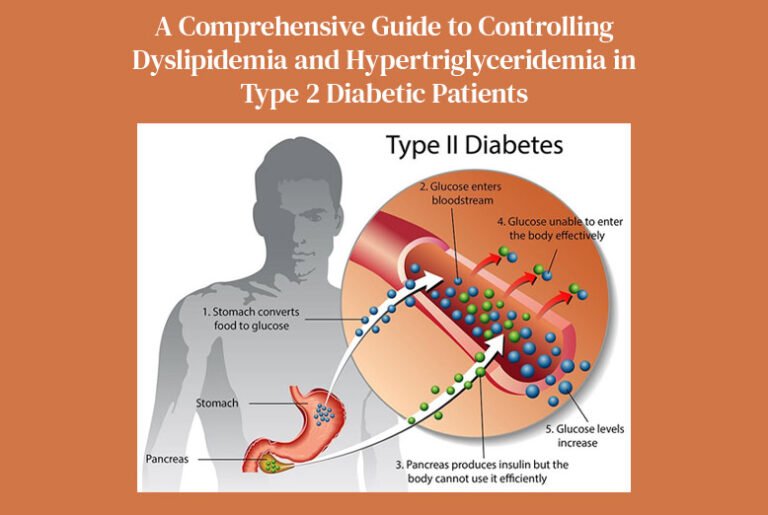High LDL cholesterol and high triglycerides are the general complaints among those patients diagnosed with type 2 diabetes. Both these conditions are caused due to an abnormal level of lipids in the blood. It may deteriorate to the extent of posing a risk of cardiovascular complications if left unabated. Thus, their management may be facilitated with medications like Saroglitazar tablets. Saroglitazar tablets uses include maintaining levels of lipids, especially triglycerides. Medications, Cornerstone of therapy: Lifestyle modification. The most important change is diet. Here, it is possible to discuss about prevention of dyslipidemia and hypertriglyceridemia in type 2 diabetes mellitus.
A brief about Dyslipidemia and Hypertriglyceridemia associated with Type 2 Diabetes
This is a relative integration of lipids in the blood with the components comprising cholesterol and triglycerides. Such dyslipidemia that is associated with such a condition is called hypertriglyceridemia, which involves high triglyceride levels. As for type 2 diabetes, because of insulin resistance, lipid metabolism is affected; thereby, cholesterol and triglyceride levels rise, the danger of unwanted effects on blood vessels increases, and the prevalence of coronary heart and stroke diseases and other cardiovascular illnesses is accelerated.
Saroglitazar tablets in patients with dyslipidemia and hypertriglyceridemia in patients with diabetes
Saroglitazar could be the best agent and has been used effectively for dyslipidemia and hypertriglyceridemia, which are complications of diabetic patients. It is an unique molecule that serves to bless glycemic and lipid parameters. It decreases triglyceride and LDL cholesterol with an elevation of HDL cholesterol through the modulation of the PPAR (peroxisome proliferator-activated receptor).
Saroglitazar tablet uses comprise of:
- Triglycerides: Saroglitazar greatly decreases the triglyceride level in a patient
- Cholesterol Balance: It decreases the LDL levels along with high HDL levels
- Blood Glucose: Saroglitazar also has potential impact on blood glucose level, thus is dual action drug for patients suffering from dyslipidemia with type 2 diabetes
Lifestyle Changes for the Regulation of Lipid Profile in a Patient with Type 2 Diabetes
Although lifestyle modification is equally as important to be done along with Saroglitazar tablets for the management of dyslipidemia and hypertriglyceridemia, these modifications include diet, exercise, and other daily habits that may improve general health.
1. Chart for Food in Patients with Type 2 Diabetes for Regulation of Lipid Level
- A well-planned chart of food in patients with type 2 diabetes management for lipid level should include,
- Low-glycemic carbs: All of the whole grains, the green leafy and legumes; some will help the body manage its blood sugar better
- Lean proteins: Fish, chicken, and plant-based proteins in keeping the muscle in good shape without rekindling unhealthy fats
- Healthy fats: Avocados, olive oil, nuts for good fats that will increase levels of HDL.
- Diets. Diets that provide higher intakes of fruits, vegetables, and whole grains help to better regulate cholesterol levels while making one feel fuller and less likely to overeat.
2. Intake of Saturated and Trans Fats:
The saturated and trans fats will increase the levels of LDL and raise the triglycerides. Therefore, taking fewer amounts of fried products, processed foods, and dairy that have high levels of fats lowers the levels of unhealthy fats in your diet. Polyunsaturated and monounsaturated fats instead of saturated and trans fats contribute to healthy conditions of the heart.
3. Increase Omega-3 Fatty Acids
Omega-3 fatty acids reduce triglycerides and maintain healthy hearts. The richest sources of these good fats are fatty fish such as salmon, trout, and sardines. If you cannot consume more of that on your diet, you may be able to assist with the addition of supplements, such as fish oil, although you should ensure you consult with your physician first with the use of any supplement.
4. Be Active
It makes you sensitive to insulin; thus, you experience normal blood sugar, cholesterol, and triglyceride levels. Engage in brisk walking, cycling, or swimming, among other activities, to rack up at least 150 minutes per week of moderate-intensity aerobic activity. Exercise does not only contribute to improving lipid levels but also improves cardiovascular function in general.
5. Be Careful With the Portion Sizes
Portion control is also necessary for the lipid and blood sugar level control. Having a food chart for type 2 diabetes gives some idea of the portion size, in an attempt not to overindulge, thus balanced intake would be achieved during mealtime .
Eating smaller, more frequent meals will help level out blood sugars and blunt those peaks that are dangerous for the lipid levels.
Monitoring of lipid and blood glucose levels
Patients on treatment for dyslipidemia and hypertriglyceridemia must have follow-up when the patient also has type 2 diabetes. Follow-up frequency
After the diagnosis of type 2 diabetes, proper assessment of fasting blood lipid profiles and triglycerides along with HbA1c-an average statistical measure of the average blood glucose-will enable the physician to observe how the treatments, such as Saroglitazar tablet therapy with lifestyle modification, help in correcting dyslipidemia and hypertriglyceridemia. The treatment will then be adjusted according to the findings of the test-result medication may be adjusted or dosages or combination treatments.
Risk Factors Most Likely to Cause Lipid Imbalances in a Type 2 Diabetes Patient
Among the many risk factors that are most likely to cause a disturbance of lipid in a patient suffering from type 2 diabetes include;
- Poor diet: The lipid levels, including triglycerides and LDL are high due to high sugar content, saturated fats and intake of refined carbohydrates.
- Poor lifestyle: The disease will aggravate because lack of physical activity causes insulin resistance which generates a disorder of lipid.
- Obesity: General and central obesity is linked with diabetes as well as dyslipidemia
- Tobacco smoking: Tobacco smoking decreases the level of HDL. In a diabetic patient, this susceptibility of heart disease even raises.
- Heavily drinking alcohol: Alcohol may increase the triglyceride level. For such patients suffering from hypertriglyceridemia, they must cut down on their alcohol consumption.
Diet with Adequate Intake in Dyslipidemia
Diet plays the most basic role in handling dyslipidemia and hypertriglyceridemia. Balanced type 2 diabetes food chart– A balanced diet ensures the uptake of nutrients, which helps control blood sugar levels; it also reduces bad cholesterol, thereby showing care for heart conditions. Here are some more tips towards a balanced diabetes-friendly diet-
- Increase Fiber Intake: Oats, barley, and beans contain soluble fiber that controls cholesterol by stabilizing blood sugar levels.
- Change your carbohydrate intake: Instead of taking refined carbohydrates, take brown rice, quinoa, and whole wheat to maintain your lipid levels intact.
- Avoid high sugar food: High sugar foods cause an insulin spurt that complicates the dyslipidemia and triglyceride scenario
- Hydrate with more water: Water will support metabolism along with digestion of the absorbed nutrients besides keeping a strict control over blood sugars and cholesterol.
- Reduce Refined Carbs: Refined carbs like white bread, pastries, and other baked products elevate the levels of blood sugar and triglycerides. Instead go for complex carbs that take a very long time to be digested.
- Relieve Stress: At times, chronic stress also leads to hormonal imbalance that changes the balance for the levels of blood sugar and lipids. Among the practices recommended include meditation, deep breathing, or yoga.
Healthcare Providers Counselling
You would need to work closely with your healthcare providers to control conditions like dyslipidemia, hypertriglyceridemia, and diabetes. The planned visits will need to alter medications such as Saroglitazar tablets so that the treatment becomes senseless. The physician must guide you through life modification in terms of a form of modality following your personal health care needs.
Conclusion
Combined medicinal management lifestyle modifications along with proper monitoring are required in the management of dyslipidemia and hypertriglyceridemia of a patient suffering from type 2 diabetes. Tablet use also includes triglyceride control along with better cholesterol balance; hence, Saroglitazar turns out to be a useful tool for lipid management among the diabetic population. Healthy dieting and exercising with adherence to the type 2 diabetic food chart are essential for maximum benefit. The active management of lipid levels cuts risks for complications in diabetic patients and improves quality of life.
Also Read: The Impact of O2 Tablets on Your Daily Wellness Routine



